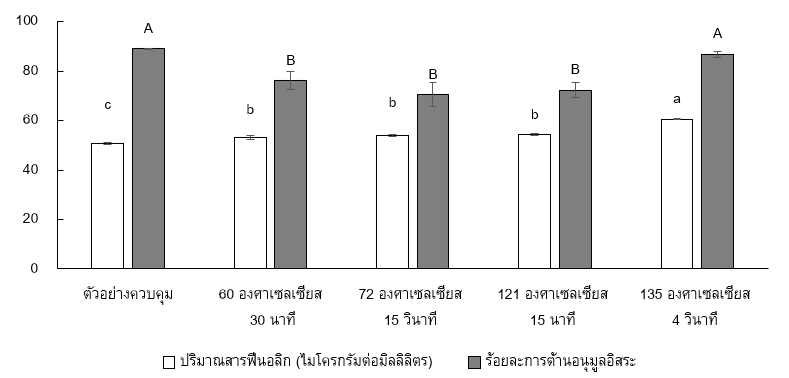Effects of thermal processing on lycopene, vitamin C, total phenolic, and antioxidant activity in tomato juice
Keywords:
Tomato, Lycopene, Vitamin C, Phenolic compound, Antioxidant activityAbstract
Heating is a beneficial method to extend the shelf life of food. However, the heating conditions affect the active substances and antioxidant activity of the processed food. This study aimed to investigate the effect of heating conditions on antioxidant compounds and antioxidant activities in tomato juice. Fresh tomato juice and tomato juices that were heated at 60°C for 30 minutes, 72°C for 15 seconds, 121°C for 15 minutes, and 135°C for 4 seconds were analyzed for the chemical and physical properties. The results showed that lycopene content, vitamin C content, phenolic content, and antioxidant activity of the samples heated under different conditions were significant differences (p <0.05). The greatest increase in phenolic content was found after heating at 135 °C for 4 seconds, with a value of 60.65 µg/ml. In addition, the antioxidant activity of the sample heated at 135 °C was not different from that of the fresh tomato juice samples (p>0.05). Nevertheless, vitamin C content decreased at higher heat treatment and vitamin C was not detected in the treated sample that was heated at 135 °C. The highest increase in lycopene content was observed after heating at 72 °C, with a value of 39.04 µg/mL. As for the color values, it was found that the heat-treated samples had an increase in Hue value. The samples heated at 135 °C had the highest Hue values and the total color difference (DE*) compared to the fresh tomato juice. While the sample was heated at 72 °C had no different Hue values when compared with the fresh tomato juice samples (p>0.05). Therefore, heating at 72 °C for 15 seconds was the optimal thermal condition to process tomato juices. Since this condition resulted in the highest lycopene content in tomato juice and remained similar in color to the fresh tomato juice.
References
Sutin S. Vitamins and free radicals. Huachiew Chalermprakiet Sci Technol J. 2016; 2(1): 80-92.
Lia N, Wub X, Zhuangb W, Xiab L, Chenb Y, Wuc C, et al. Tomato and lycopene and multiple health outcomes: Umbrella review. Food Chem. 2021; 343: 128396.
Pukrushpan T. Thermal food preservation. In: The faculty members of food science and technology department, Department of Food Science and Technology, Food science & technology. 6th. Bangkok: Kasetsart University Press; 2009. p. 137-153.
Dewanto V,Wu X, Adom KK, Liu RH. Thermal processing enhances the nutritional value of tomatoes by increasing total antioxidant activity. J. Agric. Food Chem. 2002; 50: 3010-3014.
D’Evoli L, Lombardi-Boccia G, Lucarini M. Influence of heat treatments on carotenoid content of cherry tomatoes. Foods. 2013; 2: 352-363.
Luterotti S, Bicanic D, Markovi K, Franko M. Carotenes in processed tomato after thermal treatment. Food Control. 2015; 48: 67-74.
Manzo N, Santini A, Pizzolongo F, Aiello A, Romano R. Degradation kinetic (D100) of lycopene during the thermal treatment of concentrated tomato paste. Nat Prod Res. 2019; 33 (13): 1835-1841.
Rubio-Diaz DE, SANTOS A, FRANCIS DM, RODRIGUEZ-SAONA LE. Carotenoid stability during production and storage of tomato juice made from tomatoes with diverse pigment profiles measured by infrared spectroscopy J Agric Food Chem. 2010; 58: 8692–8698.
Saini RK, Bekhit AEDA., Roohinejad S, Rengasamy KRR, Keum YS. Chemical stability of lycopene in processed products: A review of the effects of processing methods and modern preservation strategies. J Agric Food Chem. 2020; 68: 712-726.
Anthon G, Barett DM. Standardization of a rapid spectrophotometric method for lycopene analysis. Acta Hort. 2007; 758: 111-127.
Demiray E, Tuley Y, Yilmaz Y. Degradation kinetics of lycopene, -carotene and ascorbic acid in tomatoes during hot air drying. LWT– Food Sci Technol. 2013; 50: 172-176.
Vinha AF, Alves RC, Barreira SVP, Castro A, Costa ASG, Oliveira MBPP. Effect of peel and seed removal on the nutritional value and antioxidant activity of tomato (Lycopersicon esculentum L.) fruits. LWT– Food Sci Technol. 2014; 197-202.
Argyropoulos D, Muller J. Effect of convective drying on quality of lemon balm (Melissa officinalis L.). Procedia Food Sci. 2011; 1: 1932-1939.
Shi, J, Le Maguer M, Bryan M, Kakuda Y. Kinetics of lycopene degradation in tomato puree by heat and light irradiation. J Food Process Eng. 2003; 25(6): 485-498.
Honda M, Watanabe Y, Murakami K, Takemura R, Fukaya T, Wahyudiono, et al. Thermal isomerization pre-treatment to improve lycopene extraction from tomato pulp. LWT– Food Sci Technol. 2017; 86: 69-75.
Knockaert G, Pulissery SK, Colle I, Buggenhout SV, Hendrickx M, Loey AV. Lycopene degradation, isomerization and in vitro bioaccessibility in high pressure homogenized tomato puree containing oil: Effect of additional thermal and high pressure processing. Food Chem. 2012; 135: 1290 – 1297.
Tchuenchieu A, Ngang JJE, Servais M, Dermience M, Kamdem SS, Etoa FX, et al. Effect of low thermal pasteurization in combination with carvacrol on color, antioxidant capacity, phenolic and vitamin C contents of fruit juices. Food Sci Nutr. 2018; 6: 736–746.
Vallverdu´-Queralt A, Medina-Remo´n A, Andres-Lacuva C, Lamuela-Raventos RM. Changes in phenolic profile and antioxidant activity during production of diced tomatoes. Food Chem. 2011; 126: 1700-1707.
Sripakdee T, Sriwicha A, Jansam N, Mahachai R, Chanthai S. Determination of total phenolics and ascorbic acid related to an antioxidant activity and thermal stability of the Mao fruit juice. Int Food Res J. 2015; 22(2): 618-624.
Rattanapanone N. Food Chemistry. 5th. Bangkok: Odeonstore; 2014. 487 p.

Downloads
Published
How to Cite
Issue
Section
License
Copyright (c) 2022 Naresuan Phayao Journal

This work is licensed under a Creative Commons Attribution-NonCommercial-NoDerivatives 4.0 International License.
ผู้นิพนธ์ต้องรับผิดชอบข้อความในบทนิพนธ์ของตน มหาวิทยาลัยพะเยาไม่จำเป็นต้องเห็นด้วยกับบทความที่ตีพิมพ์เสมอไป ผู้สนใจสามารถคัดลอก และนำไปใช้ได้ แต่จะต้องขออนุมัติเจ้าของ และได้รับการอนุมัติเป็นลายลักษณ์อักษรก่อน พร้อมกับมีการอ้างอิงและกล่าวคำขอบคุณให้ถูกต้องด้วย
The authors are themselves responsible for their contents. Signed articles may not always reflect the opinion of University of Phayao. The articles can be reproduced and reprinted, provided that permission is given by the authors and acknowledgement must be given.







